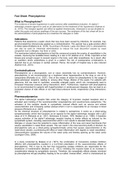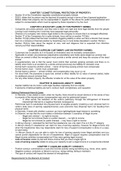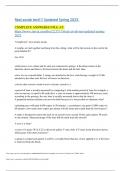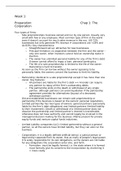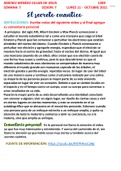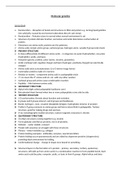Fact Sheet: Phenylephrine
What is Phenylephrine?
The incidence of severe hypotension is quite common after anaesthesia induction. An alpha-1-
adrenergic receptor agonist is used as an alternative for the treatment of this hypotension (Kalmar et
al., 2018). This receptor agonist can either be applied intravenously, intranasal or as eye droplets to
widen the pupils and reduce swellings of the eye mucosa. The emphasis of this fact sheet will be on
the administration of phenylephrine as a treatment for allergies or colds.
Indications
Patients that experience a septic shock that may have been caused by infections, for example, may
get phenylephrine intravenously applied as a contraindication. This agonist has a quite positive effect
in these cases (Kislitsina et al., 2019). According to Richards, Lopez and Maani (2021), phenylephrine
can also be used for intranasal administration to reduce the local discomfort caused by nasal
congestion due to allergies, hay fever or colds.
The mechanism behind phenylephrine is that this compound corrects the surplus of vasodilation in the
vessels, improving the available blood, leading to a rise in CO (Kalmar et al., 2018). Important is that
tissues give enough oxygen to several organs in the body, even after anaesthesia. As a result, after
an operation where anaesthesia is given to a patient, the risk of postoperative complications is
reduced due to an increase in cardiac preload. Hence, the length of hospital stay is also reduced
(Kalmar et al., 2018).
Contraindications
Phenylephrine as a decongestant, oral or nasal, essentially has no contraindications. However,
phenylephrine is not recommended as a treatment when hypersensitive to the drug or one of its
components (Richards et al., 2021). One of the modes of action for phenylephrine is the usage of
alpha-adrenergic receptors, leading to, among other things, dilation of the pupils. For patients with
glaucoma, this can lead to mydriasis, unusually enlarged pupils, which can consequently lead to
increased intraocular pressure (Drug Interactions, 2021). Furthermore, treatment with phenylephrine
is not recommended for patients with hyperthyroidism or cardiovascular diseases, this can lead to an
increased chance of side effects or too high blood pressure levels, respectively (Drug Interactions,
2021).
Pharmacodynamics
The alpha-1-adrenergic receptor falls under the category of G-protein coupled receptors and is
activated upon binding of the neurotransmitter norepinephrine and neurohormone epinephrine. The
activation of this receptor results in sympathetic induced effects such as venous and arterial
vasoconstriction and increasing cardiac preload which in turn is responsible for an increase in blood
pressure (Richards et al., 2021).
As the chemical structure of phenylephrine is related to epinephrine, it works as a direct-acting
sympathomimetic amine that functions as an agonist for the alpha-1adrenergic receptor with a pD2
value of 6.13 (Richards et al., 2021; Schümann & Endoh, 1976; Barbieri et al., 1998). It therefore
causes activation of the alpha-1-adrenergic receptor leading to similar effects as induced by the
sympathetic system, including vasoconstriction which in turn results in elevated blood pressure.
Allergies or viruses have the potential to cause inflammation of the nose and nasal membranes that
causes vasodilation in nasal blood vessels. This can result in the nose becoming stuffy or blocked. As
phenylephrine acts as a direct-acting sympathomimetic amine that causes vasoconstriction in the
nasal blood vessels, counteracting the effect of nasal inflammation with regards to nasal vasodilation.
Vasoconstriction increases the volume of the nasal cavity and thereby opening up the nasal cavity
(Lexington Clinic, 2004).
In a study conducted by Boakes et al. (1973), the combination of monoamine oxidase inhibitors
(MAOs) with phenylephrine resulted in a 2-2.5-fold potentiation of the vasoconstrictive effects of
phenylephrine. This is due to the fact that monoamine oxidase inhibitors are responsible for the
breakdown of noradrenaline (Boakes et al., 1973). Inhibiting this enzyme leads to an increase in
noradrenaline release by sympathetic neurons. Therefore, the sympathetic effects already mimicked
by phenylephrine will get amplified, leading to the so-called ‘cheese effect’, which is characterized by
What is Phenylephrine?
The incidence of severe hypotension is quite common after anaesthesia induction. An alpha-1-
adrenergic receptor agonist is used as an alternative for the treatment of this hypotension (Kalmar et
al., 2018). This receptor agonist can either be applied intravenously, intranasal or as eye droplets to
widen the pupils and reduce swellings of the eye mucosa. The emphasis of this fact sheet will be on
the administration of phenylephrine as a treatment for allergies or colds.
Indications
Patients that experience a septic shock that may have been caused by infections, for example, may
get phenylephrine intravenously applied as a contraindication. This agonist has a quite positive effect
in these cases (Kislitsina et al., 2019). According to Richards, Lopez and Maani (2021), phenylephrine
can also be used for intranasal administration to reduce the local discomfort caused by nasal
congestion due to allergies, hay fever or colds.
The mechanism behind phenylephrine is that this compound corrects the surplus of vasodilation in the
vessels, improving the available blood, leading to a rise in CO (Kalmar et al., 2018). Important is that
tissues give enough oxygen to several organs in the body, even after anaesthesia. As a result, after
an operation where anaesthesia is given to a patient, the risk of postoperative complications is
reduced due to an increase in cardiac preload. Hence, the length of hospital stay is also reduced
(Kalmar et al., 2018).
Contraindications
Phenylephrine as a decongestant, oral or nasal, essentially has no contraindications. However,
phenylephrine is not recommended as a treatment when hypersensitive to the drug or one of its
components (Richards et al., 2021). One of the modes of action for phenylephrine is the usage of
alpha-adrenergic receptors, leading to, among other things, dilation of the pupils. For patients with
glaucoma, this can lead to mydriasis, unusually enlarged pupils, which can consequently lead to
increased intraocular pressure (Drug Interactions, 2021). Furthermore, treatment with phenylephrine
is not recommended for patients with hyperthyroidism or cardiovascular diseases, this can lead to an
increased chance of side effects or too high blood pressure levels, respectively (Drug Interactions,
2021).
Pharmacodynamics
The alpha-1-adrenergic receptor falls under the category of G-protein coupled receptors and is
activated upon binding of the neurotransmitter norepinephrine and neurohormone epinephrine. The
activation of this receptor results in sympathetic induced effects such as venous and arterial
vasoconstriction and increasing cardiac preload which in turn is responsible for an increase in blood
pressure (Richards et al., 2021).
As the chemical structure of phenylephrine is related to epinephrine, it works as a direct-acting
sympathomimetic amine that functions as an agonist for the alpha-1adrenergic receptor with a pD2
value of 6.13 (Richards et al., 2021; Schümann & Endoh, 1976; Barbieri et al., 1998). It therefore
causes activation of the alpha-1-adrenergic receptor leading to similar effects as induced by the
sympathetic system, including vasoconstriction which in turn results in elevated blood pressure.
Allergies or viruses have the potential to cause inflammation of the nose and nasal membranes that
causes vasodilation in nasal blood vessels. This can result in the nose becoming stuffy or blocked. As
phenylephrine acts as a direct-acting sympathomimetic amine that causes vasoconstriction in the
nasal blood vessels, counteracting the effect of nasal inflammation with regards to nasal vasodilation.
Vasoconstriction increases the volume of the nasal cavity and thereby opening up the nasal cavity
(Lexington Clinic, 2004).
In a study conducted by Boakes et al. (1973), the combination of monoamine oxidase inhibitors
(MAOs) with phenylephrine resulted in a 2-2.5-fold potentiation of the vasoconstrictive effects of
phenylephrine. This is due to the fact that monoamine oxidase inhibitors are responsible for the
breakdown of noradrenaline (Boakes et al., 1973). Inhibiting this enzyme leads to an increase in
noradrenaline release by sympathetic neurons. Therefore, the sympathetic effects already mimicked
by phenylephrine will get amplified, leading to the so-called ‘cheese effect’, which is characterized by

